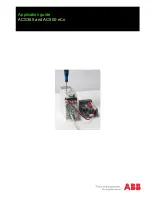
FAX 5/10/20/30/40KW
October 28, 2013
4
‐
13
888
‐
2720
‐
001
WARNING:
Disconnect
primary
power
prior
to
servicing.
Copyright
©2013,
Harris
Broadcast
Remote
control
functions
are
located
on
board.
The
User
Interface
J1
on
the
rear
panel
interfaces
to
the
opto
‐
couplers.
This
is
the
only
remote
control
available
in
backup
mode.
RF
Mute
and
TX
OFF
inputs
can
be
defeated
by
setting
dipswitches.
There
are
also
four
programmable
Status
outputs
that
are
user
definable,
a
computer
must
connected
via
Ethernet
to
set
this
up.
There
are
two
interlocks
available
External
and
Equipment.
The
External
Interlock
must
be
closed
or
the
transmitter
will
not
operate.
If
the
External
Interlock
is
opened
during
operation
the
transmitter
shuts
down
and
requires
a
TX
ON
command
to
resume.
Equipment
Interlock
when
pulled
low
will
shut
the
transmitter
off,
when
switched
hi
the
transmitter
will
resume
normal
operation.
There
are
remote
analog
voltage
outputs
for
System
Forward
Power,
System
Reflected
Power,
PA
Voltage
and
Total
PA
Current
(DC).
The
forward
and
reflected
power
detectors
are
identical
circuits.
These
are
fed
from
the
same
port
on
the
System
directional
coupler.
Using
the
same
port
and
having
identical
detectors
and
control
of
the
gain
in
the
detector
path
allows
for
automatic
calibration
of
reflected
power
without
adding
a
mismatch
or
swapping
cables
on
the
coupler.
When
calibrating
the
system
power
the
the
user
inputs
the
TPO
to
calibrate
to
and
the
AGC
is
turned
off,
this
allows
the
power
to
be
adjusted
without
fighting
the
power
control.
The
gain
through
the
detector
path
is
set
to
minimum
at
this
point.
Phase
1
is
complete.
Next
step
is
to
set
the
exciter
RF
power
so
the
transmitter
forward
power
as
read
on
a
external
meter
is
same
as
the
user
TPO
entered.
When
the
calibration
routine
is
started
the
controller
will
set
the
gain
to
get
3.5
VDC
for
a
forward
power
sample.
THe
controller
then
turn
calibrate
to
ON
(Same
as
setting
S2
‐
8
to
ON)
and
this
puts
a
2
VDC
reference
on
each
gain
stage
input.
The
micro
reads
the
voltage
at
the
output
of
the
forward
power
stage,
then
adjusts
the
reflected
stage
gain
until
it
matches
the
forward
stage
voltage
output.
Calibration
is
turned
off
and
the
TPO
is
set
to
equal
the
3.5
VDC.
Reflected
is
then
calculated
based
on
the
3.5
VDC
being
1.5:1
relative
to
the
TPO
set.
VSWR
Fault
and
foldback
as
well
as
Forward
Power
limit
are
implemented
in
hardware.
The
Forward
Power
limit
is
set
to
10%
above
the
TPO
calibrated.
This
is
done
off
the
3.5
VDC
reference
that
was
established
during
the
calibration
routine.
The
3.5
VDC
from
the
forward
power
detector
stage
is
sent
to
a
comparator
circuit,
when
the
forward
power
exceeds
110%
of
TPO
the
comparator
output
increases.
The
forward
power
limit
is
fed
to
the
APC
which
limits
the
it
from
increasing
system
power.
VSWR
has
two
thresholds,
foldback
and
fault.
The
foldback
threshold
is
user
settable
in
the
GUI
in
the
range
of
1.3
to
1.5:1.
Based
on
the
3.5
VDC
sample
that
is
equal
to
1.5:1
relative
to
the
TPO
calibrated,
the
hardware
setpoint
is
1.3:1
for
foldback.
If
the
user
sets
this
to
a
higher
value
the
micro
increases
the
comparator
reference
voltage
to
set
the
trip
point
higher.
In
backup
control
mode
this
defaults
back
to
1.3:1.
The
VSWR
Fault
is
set
to
1.5:1
in
hardware.
When
the
VSWR
exceeds
1.5:1
a
resettable
latch
is
set
which
sends
a
System
Fault
OFF
command
to
the
micro.
The
micro
will
shut
the
transmitter
off
and
attempt
to
bring
the
transmitter
back
on,
or
Restrike.
The
micro
module
will
attempt
to
restrike
the
transmitter
three
times
before
is
stays
off.
The
advance
3
‐
strike
is
only
available
in
Normal
Control
mode.
The
faults,
powers,
voltages
and
currents
are
all
multiplexed
back
to
the
micro
module.
The
control
and
switching
circuitry
are
located
on
the
System
Interface
board.
In
the
case
of
multiple
power
blocks
and
cabinets
these
lines
would
be
sent
to
the
Multi
‐
Unit
Interface
board.
Figure 4-12 System Interface Control Board
Summary of Contents for Flexiva FAX 5KW
Page 2: ......
Page 8: ......
Page 10: ...WARNING Disconnect primary power prior to servicing...
Page 167: ......
















































